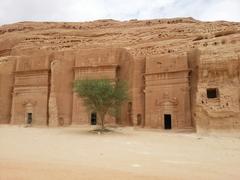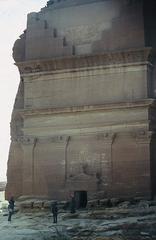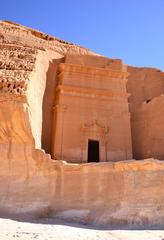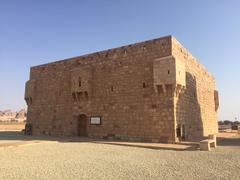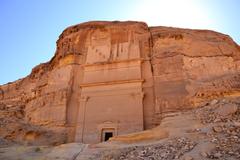Musa bin Nusayr Castle: Comprehensive Visiting Guide to Hours, Tickets, and Historical Sites in Medina Province
Date: 15/06/2025
Introduction
Perched atop a dramatic rocky hill overlooking the verdant oasis of Old AlUla, Musa bin Nusayr Castle (قلعة موسى بن نصير) is a cornerstone of Saudi Arabia’s historical and cultural landscape. As one of the oldest surviving structures in AlUla—tracing its origins as far back as the 6th century BCE—this fortress is a remarkable testament to ancient engineering, military strategy, and the region’s evolving identity. Its strategic location once provided vital protection over key caravan routes linking the Levant to Mecca and Medina, while its enduring silhouette continues to symbolize AlUla’s significance through pre-Islamic and Islamic eras (ar.wikipedia; welcomesaudi).
Although the castle predates the Umayyad general Musa ibn Nusayr by centuries, local tradition and Islamic history have intertwined his legacy with the site, adding layers to its cultural resonance (en.wikipedia). Thanks to ongoing conservation guided by the Royal Commission for AlUla and UNESCO standards, visitors today can explore the castle’s robust sandstone walls, climb its ancient steps, and experience panoramic vistas that once watched over a crossroads of civilizations (saudipedia).
This guide offers everything you need for an enriching visit: historical context, architectural highlights, practical visitor tips, ticketing details, accessibility information, and recommendations for nearby attractions. Whether you’re a history devotee or a casual explorer, Musa bin Nusayr Castle is an essential stop on any AlUla itinerary (Saudi Arabia Visa News; Regency Holidays).
Historical Overview
Early Origins and Construction
Musa bin Nusayr Castle’s earliest foundations date to the 6th century BCE, establishing it as the oldest building in Old AlUla (ar.wikipedia; saudipedia). Its commanding site was chosen for its natural elevation, which provided both defensive strength and a wide view of the valley and trade routes below. Built from local sandstone and reinforced with mudbrick, the design reflects sophisticated knowledge of desert fortifications.
Strategic Role in Ancient AlUla
The castle’s primary function was to oversee and defend the trade routes passing through AlUla, a crucial junction for caravans moving between the Levant, Mecca, and Medina (welcomesaudi). The settlement that grew around it—Old AlUla—flourished under the castle’s protection, with tightly packed mudbrick homes and lively markets.
The Umayyad Connection
Although the castle’s origins are pre-Islamic, its association with the Umayyad general Musa ibn Nusayr (c. 640–716 CE) is a defining feature of its later history (en.wikipedia). According to tradition, Musa ibn Nusayr stayed at the fortress during his campaigns, cementing its place in Islamic memory and giving the site its current name (ar.wikipedia).
Architectural Features and Defensive Design
The castle rises about 45 meters above the old town, with thick sandstone walls, corner towers, and a network of observation points (destinationksa). A stone staircase of more than 300 steps winds up the hillside, and a well carved into the rock ensured a secure water supply during sieges.
Restoration and Preservation
Centuries of use and adaptation left their mark, but recent restoration—guided by the Royal Commission for AlUla—has stabilized the structure and enhanced visitor safety. Conservation efforts remain true to the original materials and techniques, preserving the castle’s authenticity while making it accessible (saudipedia).
Cultural and Religious Context
Positioned near Masjid Al-Izam—linked to the Prophet Muhammad’s era—the castle represents a nexus of pre-Islamic, Islamic, and local traditions, safeguarding both pilgrimage and trade routes (saudipedia).
Visitor Information
Visiting Hours
- Standard hours: 9:00 AM to 6:00 PM daily.
- Seasonal variations: Hours may be adjusted during holidays or special events.
Tickets and Entry
- Standard entry fee: SAR 30–50 for adults; discounts for children, seniors, and residents.
- Free entry: Children under 6 and local residents (ID required).
- Ticketing: Purchase at the site or online via the official AlUla tourism website.
- Combined passes: Available for Old AlUla heritage sites.
Guided Tours
- Languages: Arabic, English, and others on request.
- Duration: 1–3 hours; typically includes Old Town and other key sites.
- Booking: Recommended in advance during peak season.
Accessibility
- Mobility: The climb involves steep stone steps; not fully accessible for wheelchairs.
- Lower terraces: Suitable for visitors with limited mobility.
- Facilities: Restrooms and seating areas near the entrance.
Safety and Comfort
- Footwear: Closed-toe, non-slip shoes are essential.
- Hydration: Bring water, especially in warmer months.
- Sun protection: Hats, sunscreen, and sunglasses recommended.
- Supervision: Children should be closely supervised due to steep drops and staircases.
Photography and Views
- Best times: Sunrise and sunset for optimal lighting and panoramic views.
- Recommended spots: Main observation platform, castle walls, and towers.
Cultural Etiquette
- Dress modestly in accordance with local customs.
- Avoid photographing residents without permission.
- Access may be restricted during prayer times.
Facilities and Amenities
- Restrooms: Located near the entrance.
- Cafés and shops: In Old Town, offering local handicrafts and refreshments.
- Information desk: Multilingual staff and maps available.
Events and Festivals
- Optimal season: October to March (mild weather, cultural festivals).
- Special events: Traditional music, art exhibitions, and storytelling sessions often held at the castle during festivals (Regency Holidays).
Sustainability and Preservation
- Do not climb on fragile structures or remove stones.
- Follow marked paths to help preserve the site.
Nearby Attractions
- AlUla Old Town: Explore mudbrick houses, historic markets, and museums.
- Masjid Al-Izam: Visit the mosque with deep historical roots.
- AlUla Museum: Learn about the area’s archaeology and civilizations.
- Elephant Rock: A natural sandstone formation and a favorite photography site.
- Hegra (Madain Salih): UNESCO World Heritage site with Nabataean tombs.
Frequently Asked Questions (FAQ)
Q: What are the castle’s visiting hours?
A: 9:00 AM to 6:00 PM daily, but check during special events for any changes.
Q: How much are tickets?
A: SAR 30–50 for adults; discounts or free entry for children, seniors, and residents.
Q: Are guided tours available?
A: Yes, in multiple languages; booking ahead is recommended.
Q: Is the castle accessible for visitors with disabilities?
A: The lower levels are accessible, but steep steps limit access to the summit.
Q: What else can I visit nearby?
A: AlUla Old Town, Masjid Al-Izam, AlUla Museum, Elephant Rock, and Hegra.
Visuals and Interactive Elements
Insert high-resolution images:
- Entrance to Musa bin Nusayr Castle in Old AlUla (alt text: “Entrance to Musa bin Nusayr Castle in Old AlUla”)
- Panoramic sunset view from the castle observation platform (alt text: “Panoramic sunset view from Musa bin Nusayr Castle overlooking Old AlUla”)
- Stone staircase inside the castle (alt text: “Stone staircase inside Musa bin Nusayr Castle carved into rock”)
Interactive map: Embed a map showing the castle’s location relative to other AlUla historical sites.
Practical Tips
- Book tickets and tours in advance for peak travel periods.
- Visit during cooler months (October–March) for the most comfortable experience.
- Combine your visit with Old Town and Hegra for a complete cultural itinerary.
- Download the Audiala app for guided tours, maps, and updates.
Internal Links
Summary and Final Recommendations
Musa bin Nusayr Castle stands as a powerful symbol of AlUla’s ancient and Islamic heritage, offering visitors a unique blend of historical intrigue, architectural marvels, and sweeping desert vistas. Through carefully planned restoration and sustainable tourism, the castle remains accessible for those eager to explore its storied walls and the vibrant Old Town below (saudipedia; Near+Far Magazine).
Make the most of your journey by planning ahead, respecting local customs, and engaging with knowledgeable guides. For the latest visitor information and enriching experiences, utilize digital resources such as the official AlUla tourism website and the Audiala app. Immerse yourself in the living history of AlUla—where every stone tells a story, and each view inspires awe.
المصادر والمراجع
- ar.wikipedia
- welcomesaudi
- en.wikipedia
- saudipedia
- Saudi Arabia Visa News
- Near+Far Magazine
- Regency Holidays

